
It is all too easy for the novice of French cooking to think that all sauce preparations are delineated in recipes, long ago inscribed in some large book of official cooking instruction. Nothing can be farther from the truth. Recipes for hundreds of sauces do exist in French cooking. (Some can even be found in the archives of this web site.) But in reality, the sauce component of a French dish is often “created” au moment—on the spot—just before serving.
If you peruse the classics of French cooking, such as Escoffier’s Guide Culinaire, you’ll find hundreds of sauce recipes. Many of these sauces, although classic preparations, are in reality, variations on a theme—change one ingredient and Sauce A becomes Sauce B. By applying a bit of imagination, it is possible to see the recipes as elements of a matrix rather than individual prescriptions.
The sauce recipes that form my favorite example of the above premise are those based on a fond, whether fond de viande or fond de volaille. The French word fond is usually translated “stock,” although the word had many other meanings. But to just call it stock is, in a sense, not to describe it completely. French fonds have intense flavor, and when reduced produce exquisite glaces and demi-glaces. For the uninitiated, fonds and their variations may seem like either a mystery or too much work, but actually, a basic version can easily be achieved with inexpensive ingredients and a modicum of time. The instructions included here will produce a fond, demi-glace, or glace de volaille in little time and for little expense. The results can easily be used in the sauce matrix shown below.
The matrix consists of four basic elements: a garniture de base, a déglaçage, the fonds, and a liaison or finition. All of the elements are in one sense, optional, except the fonds—although you probably wouldn’t make a sauce just from a fond. Sauces au moment generally accompany meat, poultry, or fish that has been cooked in a pan with a minimum amount of fat. The cooking leaves behind caramelized juices that become part of the finished sauce. After the main ingredient is removed from the pan and any excess fat discarded, the optional garniture de base is added to the cooking pan and is itself cooked an appropriate amount. Juices expelled during this phase start to cause the burned-on bits of caramelized juices to release from the surface of the pan and melt.
Next the pan is optionally deglazed with a liquid, the déglaçage. This process, along with some scraping with a spatula, cause the remaining bits of juices to give up their grip on the bottom of the pan and dissolve into the deglazing liquid. The deglazing liquid is usually reduced almost totally. This process concentrates the flavors of the liquid and encapsulates the flavors of the caramelized juices and of the ingredient used as the initial graniture.
Next, the fond is added. Depending on the end result desired, the fond can be a lighter version, such as bouillon, or a richer version, such as a demi-glace or glace. No matter which is used, it will be reduced either a little or substantially. Use of a bouillon or fond will result in a thin sauce, whereas use of a demi-glace or glace will generally result in a rich sauce that can be as thick as heavy syrup.
In many cases the sauce is complete at this point, but in others, an additional ingredient is added. This can be a liaison added to thicken the sauce and increase its apparent richness. Or it can be a finition added to increase the complexity of the sauce. In some cases, both can be added. Also in some recipes, the sauce is strained before the final ingredients are added.
The matrix below delineates some of the possibilities of the various components of a sauce au moment. The column on the right lists a number of classic sauces that can be accomplished from the various components. Placing your cursor over a sauce name will cause its specific components to be highlighted. The source of the sauce recipes is Louis Saulnier’s compendium of 6000 recipes first published in 1914, Le Répertoire de la Cuisine. Recipes with the same title in other books may be prepared from a different set of ingredients. Placing your cursor over any ingredient name will cause the English translation of each term to appear.

 |
 |
 |
 |
 |
|||||||
|
|
|
|
|

An example of a sauce created from elements on the matrix can be found here.
Although the above matrix was based on fonds, other matrices could be formulated around other groups of French sauces, such as those based on a béchamel, an emulsion, or cream. The possibilities are not endless but they do encompass a large part of the body of classic French sauces.





















































































































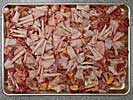
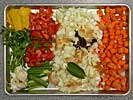 My preferred combination of meat for this recipe is chicken feet and wings in the approximate proportions listed above. I use chicken wings because they are inexpensive and have a high ratio of meat to bone. The feet are used to impart more gelatin to the final glace than would be produced by using just wings. The gelatin causes the final glace to solidify firmly when chilled. I often substitute other pieces of chicken carcass for the wings because whenever I bone a chicken for some other use, I save the bones in the freezer instead of discarding them. I also substitute bones from other meats—the picture has both quail and rabbit bones, as well as chicken carcass, added to the wings and feet. Also, half a cow’s foot or a pig’s foot can be substituted for the chicken feet as a source of gelatin.
My preferred combination of meat for this recipe is chicken feet and wings in the approximate proportions listed above. I use chicken wings because they are inexpensive and have a high ratio of meat to bone. The feet are used to impart more gelatin to the final glace than would be produced by using just wings. The gelatin causes the final glace to solidify firmly when chilled. I often substitute other pieces of chicken carcass for the wings because whenever I bone a chicken for some other use, I save the bones in the freezer instead of discarding them. I also substitute bones from other meats—the picture has both quail and rabbit bones, as well as chicken carcass, added to the wings and feet. Also, half a cow’s foot or a pig’s foot can be substituted for the chicken feet as a source of gelatin.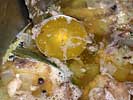
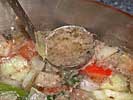 Place all the ingredients in a large stock pot (or divide the ingredients over multiple pots if more glace is being prepared). Place the pot(s) over high heat and bring to a boil. When the liquid begins to boil, gradually reduce the heat to produce a very low boil. As all the contents come up to heat, the level of the heat under the pot can be set fairly low to maintain the low boil. When the water initially comes to a boil, a gray scum will rise to the top. This should be skimmed from the surface with a small ladle or spoon. As the cooking proceeds, the scum will be replaced by yellow fat. This should also be carefully skimmed from the surface. Once the low boil is established at low heat, I check the pot and skim the surface only about once an hour.
Place all the ingredients in a large stock pot (or divide the ingredients over multiple pots if more glace is being prepared). Place the pot(s) over high heat and bring to a boil. When the liquid begins to boil, gradually reduce the heat to produce a very low boil. As all the contents come up to heat, the level of the heat under the pot can be set fairly low to maintain the low boil. When the water initially comes to a boil, a gray scum will rise to the top. This should be skimmed from the surface with a small ladle or spoon. As the cooking proceeds, the scum will be replaced by yellow fat. This should also be carefully skimmed from the surface. Once the low boil is established at low heat, I check the pot and skim the surface only about once an hour.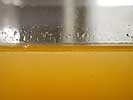
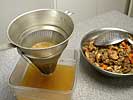
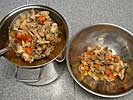 The soup is cooked sufficiently when a light broth is produced and the liquid has reduced by about one-third. Retaining as much broth as possible, strain the broth through a fine chinois into a container suitable for chilling the strained broth. As seen in the picture, even though the fat was skimmed, some will still remain. This will quickly form at the surface of the cooling soup. Chill the broth overnight in a refrigerator.
The soup is cooked sufficiently when a light broth is produced and the liquid has reduced by about one-third. Retaining as much broth as possible, strain the broth through a fine chinois into a container suitable for chilling the strained broth. As seen in the picture, even though the fat was skimmed, some will still remain. This will quickly form at the surface of the cooling soup. Chill the broth overnight in a refrigerator.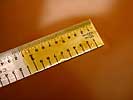
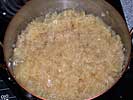
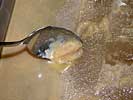 The next day, use a spoon to carefully scrape the congealed fat from the surface of the chilled broth. The broth should be a loose jelly, not liquid, when it is fully chilled. Transfer the jelly to a large saucepan and bring to a full boil. When the broth has been reduced by about one third, a demi-glace will be the result. Reducing the liquid by two-thirds will produce a glace. A convenient way to determine how far the reduction has come is to measure the depth of the liquid with a small metal ruler at the start and then periodically during the reduction. When the liquid has reduced to a glace, it will be syrupy and easily coat the ruler.
The next day, use a spoon to carefully scrape the congealed fat from the surface of the chilled broth. The broth should be a loose jelly, not liquid, when it is fully chilled. Transfer the jelly to a large saucepan and bring to a full boil. When the broth has been reduced by about one third, a demi-glace will be the result. Reducing the liquid by two-thirds will produce a glace. A convenient way to determine how far the reduction has come is to measure the depth of the liquid with a small metal ruler at the start and then periodically during the reduction. When the liquid has reduced to a glace, it will be syrupy and easily coat the ruler.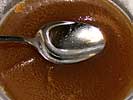 When the liquid has reduced sufficiently, ladle it into storage containers and set aside to cool in the refrigerator. The liquid will expand quite a bit if frozen so leave space in the container if you plan to freeze the results. The chilled liquid should be rather firm if reduced to a demi-glace and very firm if reduced to a glace. The demi-glace or glace will last for a week under refrigeration or for many months if frozen. Thaw frozen glace in a refrigerator before using.
When the liquid has reduced sufficiently, ladle it into storage containers and set aside to cool in the refrigerator. The liquid will expand quite a bit if frozen so leave space in the container if you plan to freeze the results. The chilled liquid should be rather firm if reduced to a demi-glace and very firm if reduced to a glace. The demi-glace or glace will last for a week under refrigeration or for many months if frozen. Thaw frozen glace in a refrigerator before using. 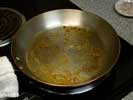 The quantities listed above are approximate and should produce enough finished sauce for 2 servings.
The quantities listed above are approximate and should produce enough finished sauce for 2 servings.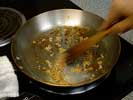 Cook the shallots in the fat remaining from cooking the steaks, or in a little hot oil or butter and oil, over medium heat. Stir the shallots continuously to prevent them from burning.
Cook the shallots in the fat remaining from cooking the steaks, or in a little hot oil or butter and oil, over medium heat. Stir the shallots continuously to prevent them from burning.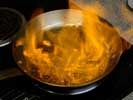
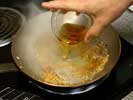 Add the cognac to the pan all at once. Increase the heat to high. When the cognac starts to boil, ignite it to burn off some of the alcohol. Boil the cognac until it reduces to a syrup. Stir occasionally to help monitor the progress of reduction, especially towards the end so the shallots don’t burn in the syrup. If you listen to the sound of the boiling liquid, you’ll hear a change as the cognac comes close to becoming a syrup. Also, the size and the frequency of the bubbles will noticeably change.
Add the cognac to the pan all at once. Increase the heat to high. When the cognac starts to boil, ignite it to burn off some of the alcohol. Boil the cognac until it reduces to a syrup. Stir occasionally to help monitor the progress of reduction, especially towards the end so the shallots don’t burn in the syrup. If you listen to the sound of the boiling liquid, you’ll hear a change as the cognac comes close to becoming a syrup. Also, the size and the frequency of the bubbles will noticeably change.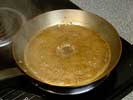
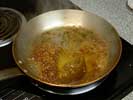 Add the glace. Move the mass around with a spatula to speed the melting of the gelatin in the glace. Carefully reduce the glace until the desired consistency is reached. As the glace reduces, the rate at which it thickens will begin to increase. If the sauce becomes too thick, add a couple of spoonfuls of stock to thin it out.
Add the glace. Move the mass around with a spatula to speed the melting of the gelatin in the glace. Carefully reduce the glace until the desired consistency is reached. As the glace reduces, the rate at which it thickens will begin to increase. If the sauce becomes too thick, add a couple of spoonfuls of stock to thin it out.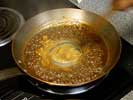 Add the mustard to finish the sauce. Either reduce the heat or remove the pan from the heat while stirring the sauce to incorporate the mustard.
Add the mustard to finish the sauce. Either reduce the heat or remove the pan from the heat while stirring the sauce to incorporate the mustard.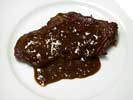 Spoon the finished sauce over the steaks, or whatever it was prepared to accompany. Note that even though all the components of the sauce are rather light in color, the finished sauce always seems to take on a pleasing, dark tone by the time it is served.
Spoon the finished sauce over the steaks, or whatever it was prepared to accompany. Note that even though all the components of the sauce are rather light in color, the finished sauce always seems to take on a pleasing, dark tone by the time it is served. 